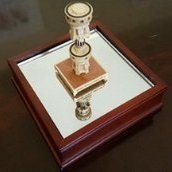Supplies of the Ship Modeler's Handbook are running out. Get your copy NOW before they are gone! Click on photo to order.
×
-
Posts
3,084 -
Joined
-
Last visited
Reputation Activity
-
 Jaager got a reaction from Canute in Buying Used Kits.
Jaager got a reaction from Canute in Buying Used Kits.
A progression from here is to forego all of the pre-made parts and scratch build. Your possibilities increase by a couple or three magnitudes. The limits here are the available plans. And if your devotion to historical accuracy has flexible limits, it will be limited by your skill either at a drawing board or a CAD program. And with a lot of the legacy plans for notorious vessels, the origins and specifics only wink the reality of what they purport to represent. But, to be fair, at the time most were produced, there was not much else available. Of course, more than a few kits share this same tenuous attachment to reality.
-
 Jaager got a reaction from mtaylor in hatches and deck camber
Jaager got a reaction from mtaylor in hatches and deck camber
Looking at a hammock from the side, I can see where that phrase would come to mind as a generally understood description. They were a lot more familiar with hammocks.
-
 Jaager got a reaction from mtaylor in Keel taper question
Jaager got a reaction from mtaylor in Keel taper question
If the rule for this is not set in the texts that we have, it was likely a situation with fairly loose limits.
For warships, I would take the start of the deadwood as being where I could start a tapper.
The ASA 1870 allows that frames can be farther apart and the space 10% wider for the final 1/5 at either end. This may be a clue as to how the strength requirements for a hull were viewed. The internal rise of the frames do not allow for as much cargo weight at the final 1/5, fore or aft, so the keel may have been allowed less mass starting there. The lengths of the keel pieces and the length of the scarphs may hold a clue. Begin a tapper - after the scarph of the last piece at either end.
Unless rich and building an America's Cup racer, I could not imagine expending money on the additional labor cost that a continuous taper would require. It would far exceed any savings on lumber for the keel.
-
 Jaager got a reaction from mtaylor in EARLY SHIPS AND SEAFARING - European Water Transport
Jaager got a reaction from mtaylor in EARLY SHIPS AND SEAFARING - European Water Transport
It is on sale at the Pen and Sword web site., right now.
-
 Jaager got a reaction from Louie da fly in EARLY SHIPS AND SEAFARING - European Water Transport
Jaager got a reaction from Louie da fly in EARLY SHIPS AND SEAFARING - European Water Transport
It is on sale at the Pen and Sword web site., right now.
-
 Jaager got a reaction from druxey in hatches and deck camber
Jaager got a reaction from druxey in hatches and deck camber
Looking at a hammock from the side, I can see where that phrase would come to mind as a generally understood description. They were a lot more familiar with hammocks.
-
 Jaager got a reaction from Canute in Byrnes machinery dust collection
Jaager got a reaction from Canute in Byrnes machinery dust collection
There are reducers for the hoses.
I saved a lot of time and bother dealing with clogged shopvac filters by using an in-line cyclone trap. The thickness sander generates impressive volumes of dust. I use it and the tablesaw in the garage.
The work done on the disk sander is more finesse than volume so I use small portable hand vac (stairs, corners, furniture, type) - a visible chamber for collection rather than a bag.
-
 Jaager got a reaction from bruce d in Keel taper question
Jaager got a reaction from bruce d in Keel taper question
If the rule for this is not set in the texts that we have, it was likely a situation with fairly loose limits.
For warships, I would take the start of the deadwood as being where I could start a tapper.
The ASA 1870 allows that frames can be farther apart and the space 10% wider for the final 1/5 at either end. This may be a clue as to how the strength requirements for a hull were viewed. The internal rise of the frames do not allow for as much cargo weight at the final 1/5, fore or aft, so the keel may have been allowed less mass starting there. The lengths of the keel pieces and the length of the scarphs may hold a clue. Begin a tapper - after the scarph of the last piece at either end.
Unless rich and building an America's Cup racer, I could not imagine expending money on the additional labor cost that a continuous taper would require. It would far exceed any savings on lumber for the keel.
-
 Jaager reacted to Louie da fly in EARLY SHIPS AND SEAFARING - European Water Transport
Jaager reacted to Louie da fly in EARLY SHIPS AND SEAFARING - European Water Transport
EARLY SHIPS AND SEAFARING - European Water Transport
Author: Professor Sean McGrail
Year: 2014
Publisher: Sword and Pen Books Ltd, Barnsley UK
ISBN: 978 1 78159 392 9
Pages: 183 pages plus index
An interesting book which traces the evolution of vessels from the most primitive to the Middle Ages. It takes a particularly archaeological viewpoint, with an emphasis on construction techniques which though very interesting, is of limited use to the ship modeller (except those really into it - to whom I doff my hat) when what we want to know is what did they look like? What were their lines? How did the rig work? Where were the belaying points? (All right, maybe that's asking a bit much . . .)
It covers maritime theory at some length - flotation, propulsion - a little offputting so early in the book, but worthy of careful study.
The author deals with two separate regions - the Mediterranean, and Northern Europe - both in the descriptions of the vessels of the time and - very interestingly - the sailing conditions; coastal configuration, weather patterns, currents, prevailing winds etc - which affected both the design of the ships and how they operated - for example why the sailing routes in the Mediterranean tended to be among the islands and coast of the north - they would avoid North Africa because it was a lee shore and almost devoid of landmarks to locate one's position.
Pictures are black and white, and one could wish for more of them.
Though the book deals very comprehensively with Northern Europe from earliest times to the late 14th century, despite foreshadowing it in the Foreword it doesn't do the same for the Mediterranean. It stops short in Late Roman times and though it covers a few wrecks, misses opportunities it should have taken. Where are the Byzantine period ships? The book was published in 2014 but makes no mention at all of the exciting Byzantine finds from Yenikapi of 2006. Not even the Serce Limani "Glass Wreck" discovered in the 1970s. And no 14th century Mediterranean ships such as the Contarina wreck.
It also gives very little attention to the pictorial record - it's very much an archaeological approach, as I mentioned above. I think in this it misses some good opportunities for theoretical reconstructions.
All in all, a bit of a "curate's egg" - some parts of it are excellent. Worth a read and it certainly contained information I'm glad of. But it could have been so much better.
-
 Jaager got a reaction from grsjax in Buying Used Kits.
Jaager got a reaction from grsjax in Buying Used Kits.
A progression from here is to forego all of the pre-made parts and scratch build. Your possibilities increase by a couple or three magnitudes. The limits here are the available plans. And if your devotion to historical accuracy has flexible limits, it will be limited by your skill either at a drawing board or a CAD program. And with a lot of the legacy plans for notorious vessels, the origins and specifics only wink the reality of what they purport to represent. But, to be fair, at the time most were produced, there was not much else available. Of course, more than a few kits share this same tenuous attachment to reality.
-
 Jaager got a reaction from Nirvana in Buying Used Kits.
Jaager got a reaction from Nirvana in Buying Used Kits.
A progression from here is to forego all of the pre-made parts and scratch build. Your possibilities increase by a couple or three magnitudes. The limits here are the available plans. And if your devotion to historical accuracy has flexible limits, it will be limited by your skill either at a drawing board or a CAD program. And with a lot of the legacy plans for notorious vessels, the origins and specifics only wink the reality of what they purport to represent. But, to be fair, at the time most were produced, there was not much else available. Of course, more than a few kits share this same tenuous attachment to reality.
-
 Jaager got a reaction from mtaylor in Buying Used Kits.
Jaager got a reaction from mtaylor in Buying Used Kits.
A progression from here is to forego all of the pre-made parts and scratch build. Your possibilities increase by a couple or three magnitudes. The limits here are the available plans. And if your devotion to historical accuracy has flexible limits, it will be limited by your skill either at a drawing board or a CAD program. And with a lot of the legacy plans for notorious vessels, the origins and specifics only wink the reality of what they purport to represent. But, to be fair, at the time most were produced, there was not much else available. Of course, more than a few kits share this same tenuous attachment to reality.
-
 Jaager got a reaction from Bob Cleek in Buying Used Kits.
Jaager got a reaction from Bob Cleek in Buying Used Kits.
A progression from here is to forego all of the pre-made parts and scratch build. Your possibilities increase by a couple or three magnitudes. The limits here are the available plans. And if your devotion to historical accuracy has flexible limits, it will be limited by your skill either at a drawing board or a CAD program. And with a lot of the legacy plans for notorious vessels, the origins and specifics only wink the reality of what they purport to represent. But, to be fair, at the time most were produced, there was not much else available. Of course, more than a few kits share this same tenuous attachment to reality.
-
 Jaager got a reaction from genocon in Buying Used Kits.
Jaager got a reaction from genocon in Buying Used Kits.
A progression from here is to forego all of the pre-made parts and scratch build. Your possibilities increase by a couple or three magnitudes. The limits here are the available plans. And if your devotion to historical accuracy has flexible limits, it will be limited by your skill either at a drawing board or a CAD program. And with a lot of the legacy plans for notorious vessels, the origins and specifics only wink the reality of what they purport to represent. But, to be fair, at the time most were produced, there was not much else available. Of course, more than a few kits share this same tenuous attachment to reality.
-
 Jaager got a reaction from Gregory in Buying Used Kits.
Jaager got a reaction from Gregory in Buying Used Kits.
A progression from here is to forego all of the pre-made parts and scratch build. Your possibilities increase by a couple or three magnitudes. The limits here are the available plans. And if your devotion to historical accuracy has flexible limits, it will be limited by your skill either at a drawing board or a CAD program. And with a lot of the legacy plans for notorious vessels, the origins and specifics only wink the reality of what they purport to represent. But, to be fair, at the time most were produced, there was not much else available. Of course, more than a few kits share this same tenuous attachment to reality.
-
 Jaager got a reaction from thibaultron in Converting a Backyard Shed into a Model Workshop
Jaager got a reaction from thibaultron in Converting a Backyard Shed into a Model Workshop
I trust that you mean this is jest. Being 3 litres negative water balance in Piedmont Carolina in Summer-like temp sort of makes it difficult to maintain the necessary internal balance and not start to denature some temperature sensitive enzymes and receptors. I think beyond a certain age, our internal thirst safety drive can get to be below the strength of signal necessary to gain our attention.
-
 Jaager got a reaction from druxey in Western Red Cedar
Jaager got a reaction from druxey in Western Red Cedar
As an indicator of the characteristics the term Cedar is all but useless. It includes several genus groups and may be more than one family. Being an aromatic conifer may be all it takes.
-
 Jaager got a reaction from Canute in Converting a Backyard Shed into a Model Workshop
Jaager got a reaction from Canute in Converting a Backyard Shed into a Model Workshop
It would be difficult to over praise the improvement an in-line cyclone type trap makes in dealing with collected saw dust, A cloth bag or straight to a vac chamber/filter just ain't in it once you see the difference.
My old Sears 16gal shop vac was like being near a jet engine - had to use ear muff sound protection. I bought a Festool Midi because it was supposed to be quiet. It is, but it is expensive as 'ell and turns itself off after 15 min. I bought a 16 gal Rigid from Home Depot that is about as quiet, pulls a hurricane, stays on, and costs less than 20% what the Festool did. I do not need hearing protection, but I still can't listen to Beethoven when its on.
Now on to your question.
This is what I have now:
https://www.rockler.com/dust-collector-remote-switch
The remote uses a common low cost battery. I unplug it when I am done - because I live in a condo and it may use the same frequency as some garage door remotes. You can guess how I discovered that. I ain't low cost, but a low cost model that clued me in on this tech, burned out.
-
 Jaager got a reaction from Canute in Unimat or Sherline... your feedback, please...
Jaager got a reaction from Canute in Unimat or Sherline... your feedback, please...
Real Unimat have been out if production for a while now. Are you looking at a second hand machine?
Of late, some real junk has been showing up with the Unimat name. Lots of plastic instead of cast Al.
-
 Jaager got a reaction from Canute in Byrnes thickness sander vs Micro Mark's
Jaager got a reaction from Canute in Byrnes thickness sander vs Micro Mark's
Bob,
No disagreement from me about any sort of Al oxide - open coat. For the longest time, I wondered what the difference was between open coat and closed coat. I was addressing the closed coat Al oxide and Si carbide and Zirconia as being the stuff that could clog. I think that the longer lasting open coat is about having a cloth or heavier paper backing and a bonding agent that is stronger and more heat from friction resistant. The teeth part should be about the same.
Dave,
Not having a ton of fine saw dust would be a plus, but at least needing protection from it, in addition to a shop vac meant that I had some N-95 masks on hand.
-
 Jaager got a reaction from Canute in Byrnes thickness sander vs Micro Mark's
Jaager got a reaction from Canute in Byrnes thickness sander vs Micro Mark's
With blades, I think thickness planner is a better description.
Aspects that I would wonder about:
How much fine control over thickness?
How often must the blades be sharpened?
How difficult is it to get at them?
What is the square surface area processed before the blades need to be replaced?
How expensive are the blades?
Is tear out a significant occurrence?
What is the difference in loss to waste compared to a sander?
Compared to a thickness sander,
I imagine it would go faster.
Require fewer passes if the layer to be removed is relatively thick.
The waste product would generally be less micro and airborne. Something that requires abatement with a sander.
If you are careless and get fingers in harms way, I would think that the amount of you lost would be more than closely trimmed nails or temporarily more sensitive finger tips.
-
 Jaager got a reaction from Canute in Byrnes thickness sander vs Micro Mark's
Jaager got a reaction from Canute in Byrnes thickness sander vs Micro Mark's
Two comments:
I buy direct from Klingspor on line. From my reading, I use open coat Al oxide as the cutting medium. It seems that the long life materials are for metals and such, wood clogs, fills the spaces.
I wish Jim had used a much stronger spring to restrain the depth wheel. But it only wants to go one way and it is wide enough that a 2" C clamp on the rim stops it by it hitting the housing.
-
 Jaager got a reaction from Canute in How to seal acrylic paint?
Jaager got a reaction from Canute in How to seal acrylic paint?
Would shellac not also do the job? Not about resisting scratches, but an easy sealing layer.
Or conservators wax?
-
 Jaager got a reaction from Canute in Power Sander
Jaager got a reaction from Canute in Power Sander
Perhaps exploring these will give you some idea of the tools available for this range of work.
I bought this under a Swedish company's brand name:
King Arthur's© Guinevere© Flexible Shaft
Heavy duty and definitely not cordless
Although the 1/3 HP motor that I use to drive it is CW/CCW - this tool is not engineered for reverse rotation.
There are a variety of disks 1" 2" 3"
It also works with my preferred drums
Peachtree Woodworking Supply Inc
Sleeveless Sanding Drums
This sanding drum design eliminates the need to buy replacement sanding sleeves for your drum sander. Cut and fold any type of sheet sandpaper to size for the particular drum size you're using. A single sheet of sandpaper and instructions are included with each individual drum.
3/4" - 1" - 2" - 3" 2.5" @ Woodcraft
if the rubber pad is removed the 3/4" becomes 1/2"
there is a 3" that is 6" high (the 4.5" high one is a waste)
I made a sanding table to mount these drums ( no oscillating, but everything I use it on has a continuously changing bevel, so I move the work. )
I dislike using sleeves.
Micro-Mark has a line of a German company's DC - corded small hand tools
Micro-Make™ / MicroLux® Heavy-Duty Right Angle Disk Sander / Drill
Works well inside a larger scale hull. pretty powerful, has a chuck that can replace the disk for more tool options.
Micro-Make™ / MicroLux® Palm-Size Belt Sander
It did a job for me very quickly that would have otherwise been slow and difficult. I had to hold it with a piece of wood to stop it throwing the belt.
It is a very aggressive tool.
Micro-Make™ / MicroLux® Orbital Sander Now with Hook and Loop System Sandpaper!
I have it, but have not used it yet. I think I prefer hand sanding for the jobs it would do.
Micro-Make™ 3D Contour Sander
The sander version of a Norelco Triple Header shaver - I did not buy this, I think my uses are too delicate to risk using it.
-
 Jaager got a reaction from Canute in Thinning Contact Cement
Jaager got a reaction from Canute in Thinning Contact Cement
I found the MDS
the solvent seems to be:
Section 3 - Composition /
Information On IngredientsChemical NameCASRN
Wt%
Toluene 108-88- 3 15-40
Acetone 67-64-1 15-40
Light aliphatic solvent naphtha 64742-89-8 7-13
n-Heptane 142-82- 5 5-10
Methylcyclohexane 108-87- 2 0.5-1.5
They do not even have a fixed ratio, just a range
It is a proprietary mixture (?) so no off the shelf solvent. Reads like some nasty stuff to breathe.
The adhesive is a rubber derivative
I have a home made thickness sander from very old NRJ plans - 11" Maple drum and used this stuff to fix the 11x9 sheet of abrasive medium. It is a job the remove and clean. Naphtha will cause it to unstick and roll into balls but still a lot of work to remove. Mineral spirits will loosen it -- eventually. No solvent have I found.
My Byrnes replacement, although 6" instead of 11", is magnitudes faster and easier to replace the media on.
If you must use it, it looks to me as though you are limited to buying the smallest size container and pitching it when it evaporates too much carrier solvent.
With straight up Best Test or Elmer's rubber cement, you can buy Bestine - n-Heptane - in pints or quarts - but this stuff looks no go.










